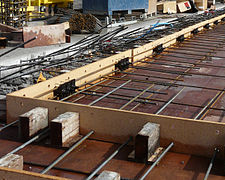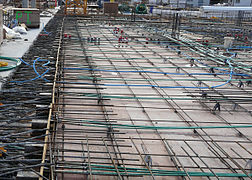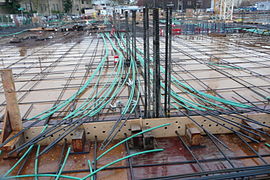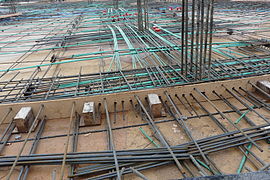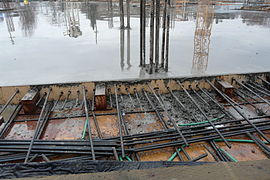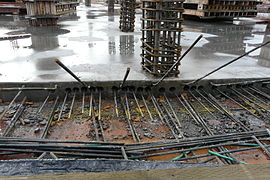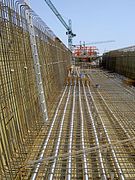Talk:Prestressed concrete
| This It is of interest to the following WikiProjects: | ||||||||||||||||||||||||
| ||||||||||||||||||||||||
Untitled
[edit]I wonder if in this article, it should be mentioned that...
Two of the forms in which prestressed concrete is often cast, include piles, slabs, hollow-core floors and girders, most of which conform to AASHTO [link] standards.
Piles are designed to be driven into the earth much as a hammer drives a nail, and must withstand strong shock forces.
Slabs are used to support great weights, and often exposed to high bending moments; thus prestressing the concrete can increase the maximum supportable weight.
Hollow-core (link to precast concrete ŝmention of hollow core) floors are cast using a low-slump mix, and cut up at the factory site.
AASHTO girders are classified according to type number and shape.
The shapes can range from I beams, to "Bulb-T" girders, so named for a cross section that looks like a T, and Double-T girders.
Merging
[edit]This article on prestressed concrete has much more depth than the post-stressed article, and both are about almost identical procceses. Enelson 23:12, 30 April 2006 (UTC)enelson
post-tensioned concrete
[edit]Q. I donkkt quite follow the description of the post-tensioned processes, especially unbonded. At what point to the tendons engage the cured concrete? Could someone please provide some diagrams, photos or a good link for this?
- A. The tendons do not engage the concrete, they are unbonded from the concrete, hence the name.
- a. That is true. Also the tendons pull the concrete shape from the ends where the tension is applied by jacks. the shape may be forced into a camber from the tensioning. Bond with the tendons is un-necesary. —Preceding unsigned comment added by 170.63.96.108 (talk) 18:03, 6 December 2007 (UTC)
I put some pictures in the article. One picture shows rolls of cable with the holding end anchors. These anchors are fastened to rebar and buried in the concrete locking one end. At the other end the coating is stripped from the cable and the cable is passed through the pulling end anchor attached to the inside of the form. After the concrete has cured the cable is stretched with a hydraulic jack. The cable is greased so that it will slide within the plastic sheathing. 24.19.45.169 (talk) 21:49, 9 March 2008 (UTC)
Diagrams
[edit]Here is an excellent diagram:

and I can convert it to english, if someone can translate it for me! --Knulclunk 03:56, 16 July 2007 (UTC)
- But what does it mean? A good description to go with it might be good. Jason A. Recliner (talk) 07:51, 2 December 2008 (UTC)
ok why exactly are the cabloes stretched after the concrete is cured?? —Preceding unsigned comment added by 98.197.49.79 (talk) 20:02, 5 October 2009 (UTC)
- (belated reply) To tension them (SA). In this manner (LA) the cables are Post-tensioned., other wise they are pretensioned. I beleive it helps make the profile of the tendons easier (parabolic)in construction to give it the right capacities for a unique construction. Other wise your dealing with different tendon configurations such as harped etc. This should (and other elevant information with sourcing of course) be added to the article if someones up for describing the differences better. Ottawa4ever (talk) 12:42, 17 September 2010 (UTC)
History
[edit]I deleted a line that claimed prestressed concrete was invented by Freyssinet, which was in contradiction to Wikipedia's own Freyssinet page.
The Portland Cement Association claims "prestressed concrete was patented by a San Francisco engineer in 1886." [1]
A brief history on prestressed concrete would improve this page. —Preceding unsigned comment added by 210.18.214.5 (talk) 05:20, 17 May 2008 (UTC)
- Freyssinet did not invent prestressing he did howver make it more mainstream and was the fiorst to apply it to a structure. The steel was created back in the 1880s as PCA mentions, but was not used in structures because high strength steel was no pratical at that point. Any of this information is common knowledge in any prestressed text book. Ottawa4ever (talk) 17:08, 24 July 2009 (UTC)
History of Problems section has problems.
[edit]The section has problems in discussing corrosion. Corrosion of the steel is inevitable. It is NOT due to workmanship or quality problems, it is due to the laws of thermodynamics. In an environment containing chloride, chloride migration into the concrete is also inevitable. This section blames quality or workmanship issues with what may be a design flaw. Certainly, the goal of sealing the steel away from moisture and corrosion causing contaminates is reasonable. But assuming there will be no contamination is NOT. We do not design houses to be waterproof because water will inevitably get in. Similarly, designs of structures should NEVER assume corrosion can be prevented, only slowed. Good design today requires the various vulnerabilities of a structure to be tested throughout the life of the structure. It is nonsense to blame workmanship for a design flaw. Assuming any grout, coating or sealant will seal perfectly is a design flaw. I am not familiar with the specific cases cited here, but the tone of this section seems to be an attempt to cast the blame for the results of poor design decisions onto the builder.Abitslow (talk) 19:18, 25 November 2013 (UTC)
- The presence and emphasis given to this section is inconsistent with how such issues are dealt with for other cnstruction materials & technologies.
- For example, historically far more failed bridges have been made from reinforced concrete, structural steel or timber over the years, and yet the Wiki articlces on these materials have no sections devoted to highlighting any bridge failures. Indeed, WP's own list of > 200 bridge failures, shows almost none of them were prestressed concrete.
- The key issues in this section (grouting quality & tendon corrosion) are not "bridge issues" per-se, but rather are risks inherent in prestressed concrete construction that need to be actively addressed in all applications. I suggest these matters are better presented in a section focussed principally on durability issues and practices.
- Geekstreet (talk) 13:11, 18 August 2016 (UTC)
Post-stress cable inspection and replacement?
[edit]As a non-expert reading this article, it sounds like the "grout and forget" procedure is unreliable and it should not be assumed the system is working. Probably should actually take a look that it is working, though the grouting around the cable likely makes this impossible.
Would it be possible to leave post-tensioned cabled ungrouted, so that at a later time they can be removed, inspected, and reinstalled, or just replaced with a new post-stress cable assembly?
I realize that releasing cable tension weakens the structure, though with two or more overlapping / crosscrossing cable layers, that would provide overall tensioned support while a single cable/bundle is being removed for inspection.
Could also build a tiny robot camera to pull through the cable hole and examine the concrete internally, plus also a traveling spray head to flush out corrosive chemicals, and to apply a sealing coat to cracks in the wall.
Probably could still leave a structure like a highway bridge in normal usage while a service shuttle travels along it, pulling cables out for inspection, doing hole inspection and cleaning, and reinstalling or replacing the post-tensioned cables.
(This general design concept is hereby released to the world by me as prior art and now may not be patented by anyone if it isn't already, though specific device applications to carry it out can probably still be patented. -- Dale Mahalko, Gilman, WI, USA.)
-- DMahalko (talk) 02:14, 10 April 2016 (UTC)
Comprehensive improvement, restructuring and sources needed
[edit]Prestressed concrete, in all its many forms, is one of the world's principal construction technologies, and the current single Wiki page doesn't cover the topic adequately or even clearly. For example, the first sentence says it's a "method", the second sentence says it's a "material", and the third sentence would probably be incomprehensible by most readers.
I have just added the Refimprove "Citations needed" template to the page as there are almost no refs given for any of the "technical" sections defining what PS concrete actually is.
It is interesting reading this page's full history. There appears to have been many good contributions made but then removed over the time. I guess this is not an uncommon occurrence, but I suspect a small number of past editors have tried to "slant" the article in directions that favour their area of endeavour, to the detriment of the quality and scope of the article as a whole. The almost complete absence of citations for these adds/dels seems telling here. I feel Wikipedia needs a set of pages that comprehensively cover the full range of PS Concrete technologies and applications used around the world, without fear or favour.
My suggested starting point is to clarify the structure of the content, possibly as follows:
- Prestressed concrete technologies
* Pre-tensioned concrete * Post-tensioned concrete * Bonded * Unbonded * Monostrand * Multistrand
- Prestressed concrete theory
* Concrete characteristics * Benefits of adding prestressing * Forces introduced by prestressing * Load balancing and force profiles * Prestress levels * Anchorage forces * Serviceability * Ultimate strength
- Prestressed concrete applications
* Building structures * Suspended * On-ground * Vertical elements * Civil structures * Bridges * Dams * Silos and tanks * Nuclear and blast containment * Pipes * Roads and pavements
- etc, ...
I admit to being pretty new here - is there any support for this approach? Geekstreet (talk) 03:31, 27 July 2016 (UTC)
- Proposed new article lead, aiming to concisely define what the subject matter is, why it exists, & how/where it is used ...
Prestressed concrete is defined as a concrete construction material which is placed under compression prior to it supporting any applied loads (ie it is "pre" stressed).[1] This compression is produced by the tensioning of high-strength "tendons" located within or adjacent to the concrete volume, and is done to improve the performance of the concrete in service.[2] Tendons may consist of single wires, multi-wire strands or threaded bars, and are most commonly made from high-tensile steels, carbon fibre or aramid fibre. The essence of prestressed concrete is that once the initial compression has been applied, the resulting material has the characteristics of high-strength concrete when subject to any subsequent compression forces, and of ductile high-strength steel when subject to tension forces. This can result in improved structural capacity and/or serviceability compared to conventionally reinforced concrete in many situations.[3]
First used in the late-nineteenth century [1], prestressed concrete has developed to encompass a wide range of technologies. Tensioning (or "stressing") of the tendons may be undertaken either before (pre-tensioning) or after (post-tensioning) the concrete itself is cast. Tendons may be located either within the concrete volume (internal prestressing), or wholy outside of it (external prestressing). Whereas pre-tensioned concrete by definition uses tendons directly bonded to the concrete, post-tensioned concrete can use either bonded or unbonded tendons. Finally, tensioning systems can be classed as either monostrand systems, where each tendon's strand or wire is stressed individually, or multi-strand systems where all strands or wires in a tendon are stressed similtaneously.[3]
Prestressed concrete is used in a wide range of building and civil structures where its improved concrete performance can allow longer spans, reduced structural thicknesses, and material savings to be realised compared to reinforced concrete. Typical applications range through high-rise buildings, foundation systems, bridge and dam structures, silos and tanks, industrial pavements and nuclear containment structures.[4]
- Initial draft Geekstreet (talk) 04:56, 17 August 2016 (UTC)
- Updated txt & refs Geekstreet (talk) 07:08, 18 August 2016 (UTC)
- Original intro txt: Re-work some of this into a new Prestressed concrete theory section (to be added next) ...
Prestressed concrete is a method for overcoming concrete's natural weakness in tension. It is a material that has the characteristics of high strength concrete in compression and high ductile strength steel for tension. The loss in material strength due to stressing can be computed and lies at the stressed concrete shape. The bending shape should be opposite of the applied force it will service. It can be used to produce beams, floors or bridges with a longer span than is practical with ordinary reinforced concrete. It is often used in commercial and residential construction as a foundation slab. Prestressing tendons (generally of high tensile strength steel cable or rods) are used to provide a clamping load which produces a compressive stress that balances the tensile stress that the concrete compression member would otherwise experience due to a bending load. Traditional reinforced concrete is based on the use of steel reinforcement bars, rebars, inside poured concrete. Prestressing can be accomplished in three ways: pre-tensioned concrete, and bonded or unbonded post-tensioned concrete.
- Original "Bonded" section following - this is all copyvio & is to be replaced.
Geekstreet (talk) 11:10, 23 August 2016 (UTC)
Bonded post-tensioned concrete
[edit]Bonded post-tensioned concrete is the descriptive term for a method of applying compression after pouring concrete and during the curing process (in situ). The concrete is cast around a plastic, steel or aluminium curved duct, to follow the area where otherwise tension would occur in the concrete element.
A set of tendons is fished through the duct and the concrete is poured. Once the concrete has hardened, the tendons are tensioned by hydraulic jacks that react (push) against the concrete member itself.
When the tendons have stretched sufficiently, according to the design specifications (see Hooke's law), they are wedged in position and maintain tension after the jacks are removed, transferring pressure to the concrete. The duct is then grouted to protect the tendons from corrosion.
This method is commonly used to create monolithic slabs for house construction in locations where expansive soils (sometimes called adobe clay) create problems for the typical perimeter foundation. All stresses from seasonal expansion and contraction of the underlying soil are taken into the entire tensioned slab, which supports the building without significant flexure.
Post-tensioning is also used in the construction of various bridges, both after concrete is cured after support by falsework and by the assembly of prefabricated sections, as in the segmental bridge.
Among the advantages of this system over unbonded post-tensioning are:
- Large reduction in traditional reinforcement requirements as tendons cannot destress in accidents.
- Tendons can be easily "woven" allowing a more efficient design approach.
- Higher ultimate strength due to bond generated between the strand and concrete.
- No long term issues with maintaining the integrity of the anchor/dead end
- Unbonded (orig text), to be reworked in non-User Manual style (WP:NOTGUIDE), and pix reduced.
- Geekstreet (talk) 08:56, 24 August 2016 (UTC)
Unbonded post-tensioned concrete differs from bonded post-tensioning by providing each individual cable permanent freedom of movement relative to the concrete. To achieve this, each individual tendon is coated with a grease (generally lithium based) and covered by a plastic sheathing formed in an extrusion process.[5] The transfer of tension to the concrete is achieved by the steel cable acting against steel anchors embedded in the perimeter of the slab. The main disadvantage over bonded post-tensioning is the fact that a cable can destress itself and burst out of the slab if damaged (such as during repair on the slab). The advantages of this system over bonded post-tensioning are:
- The ability to individually adjust cables based on poor field conditions (For example: shifting a group of 4 cables around an opening by placing 2 on each side).
- The procedure of post-stress grouting is eliminated.
- The ability to de-stress the tendons before attempting repair work.[6]
Picture number one (below) shows rolls of post-tensioning (PT) cables with the holding end anchors displayed. The holding end anchors are fastened to rebar placed above and below the cable and buried in the concrete locking that end. Pictures numbered two, three and four shows a series of black pulling end anchors from the rear along the floor edge form. Rebar is placed above and below the cable both in front and behind the face of the pulling end anchor. The above and below placement of the rebar can be seen in picture number three and the placement of the rebar in front and behind can be seen in picture number four. The blue cable seen in picture number four is electrical conduit. Picture number five shows the plastic sheathing stripped from the ends of the post-tensioning cables before placement through the pulling end anchors. Picture number six shows the post-tensioning cables in place for concrete pouring. The plastic sheathing has been removed from the end of the cable and the cable has been pushed through the black pulling end anchor attached to the inside of the concrete floor side form. The greased cable can be seen protruding from the concrete floor side form. Pictures seven and eight show the post-tension cables protruding from the poured concrete floor. After the concrete floor has been poured and has set for about a week, the cable ends will be pulled with a hydraulic jack.
References
- ^ a b Lin, T.Y.; Burns, Ned H. (1981). Design of Prestressed Concrete Structures (Third ed.). New York, U.S.A.: John Wiley & Sons. ISBN 0 471 01898 8.
- ^ Warner, R. F.; Rangan, B. V.; Hall, A. S.; Faulkes, K. A. (1988). Concrete Structures. South Melbourne, Australia: Addison Welsley Longman. pp. 8–19. ISBN 0 582 80247 4.
- ^ a b Warner, R. F.; Faulkes, K. A. (1988). Prestressed Concrete (2nd ed.). Melbourne, Australia: Longman Cheshire. pp. 1–13. ISBN 0 582 71225 4.
- ^ Post-Tensioning Institute (2006). Post-Tensioning Manual (6th ed.). Phoenix, AZ U.S.A.: PTI. pp. 5–54. ISBN 0 9778752 0 2.
- ^ How is Unbonded Post Tensioning Made?
- ^ Detensioning Unbonded Post-Tension Tendons
Stressed ribbon bridges to move
[edit]The inclusion of text & image of stressed ribbon bridges within the Pre-tensioned section is incorrect. Most if not all examples of these built in the real world (ie not in labs) will have the ribbon tendons post-tensioned while the deck is temporarily supported.[1] Some may use pre-tensioned planks as the deck elements, but the defining element of these bridges is the ribbon tendons. The reworded version takes these refs out, so they can be moved elsewhere in the article Geekstreet (talk) 07:37, 19 August 2016 (UTC)
References
- ^ Strasky, J. "Stress Ribbon Bridge". Civil Engg. Seminar. Retrieved 19 August 2016.
Unbonded post-tensioning - removed content
[edit]The original section titled "Unbonded post-tensioned concrete" (since renamed "Unbonded post-tensioning") contained many images & associated text describing details of various site operations. I feel this makes this section into a user manual in style, contrary to WP:NOTMANUAL. I have reworked the text, adding additional material but removing all the text referencing the images as I think they stand OK without it if adequately captioned. I have also removed quite a few of these "site-sequence" images but kept those which identify the key items described in the section, and gave them extended captions.
If this is not considered an improvement pls revert & discuss. Geekstreet (talk) 10:08, 24 August 2016 (UTC)
A Commons file used on this page has been nominated for deletion
[edit]The following Wikimedia Commons file used on this page has been nominated for deletion:
Participate in the deletion discussion at the nomination page. Community Tech bot (talk) 15:23, 4 July 2018 (UTC)
- Start-Class level-5 vital articles
- Wikipedia level-5 vital articles in Technology
- Start-Class vital articles in Technology
- C-Class articles with conflicting quality ratings
- C-Class Civil engineering articles
- High-importance Civil engineering articles
- WikiProject Civil engineering articles
- B-Class articles with conflicting quality ratings
- B-Class Technology articles
- WikiProject Technology articles




